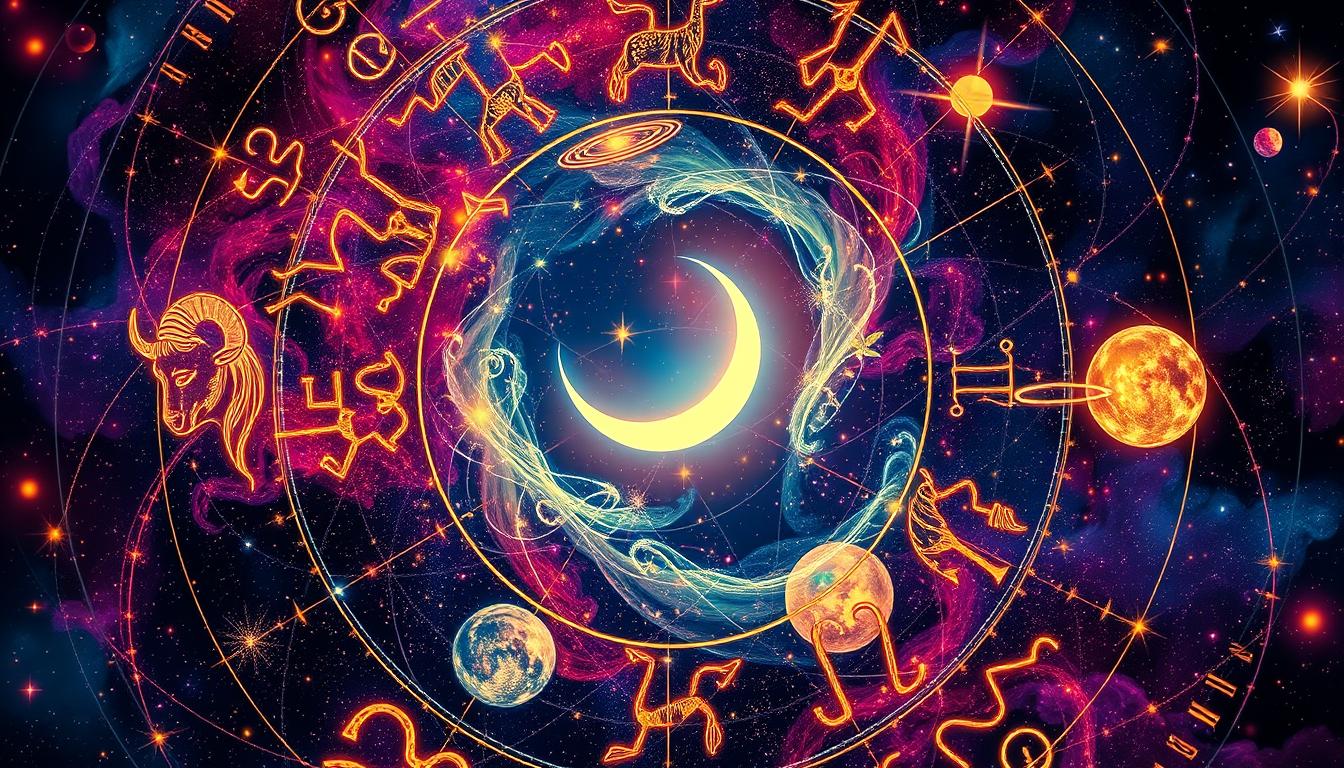Have you ever wondered why people connect so deeply with their astrological signs? The zodiac is more than just a trend—it’s a celestial map rooted in ancient traditions. For centuries, cultures like the Babylonians, Greeks, and Hindus studied the stars, linking human traits to constellations.
Today, astrology captivates millions. A 2022 survey found that 27% of Americans believe in its influence. Younger generations, especially millennials and Gen Z, embrace it even more—37% under 30 see truth in their horoscopes. From personality insights to pop culture, zodiac signs shape how we understand ourselves and others.
This guide explores the history, science, and modern relevance of astrology. Whether you’re a skeptic or a believer, there’s always something fascinating to discover. Ready to dive in?
Key Takeaways
- The zodiac has deep roots in ancient civilizations like Babylon and Greece.
- Over a quarter of Americans believe in astrology’s influence.
- Younger generations are more likely to trust horoscopes.
- Astrology connects personality traits to celestial patterns.
- Modern apps and media keep zodiac culture thriving.
What Is the Zodiac?
Astronomy and astrology share a complex relationship that’s often misunderstood. While both study the stars, their purposes differ. The zodiac, a key concept in astrology, is rooted in the path of the Sun across the sky over a year. This path, known as the ecliptic, is divided into twelve equal parts, each associated with specific personality traits.

The Astronomical Basis of the Zodiac
The zodiac’s foundation lies in astronomy. Ancient civilizations observed the Sun’s movement through twelve constellations along the ecliptic. These constellations vary in size. For example, Virgo spans 1,294 square degrees, while Cancer covers only 506 square degrees. The Sun spends 45 days in Virgo but just 7 days in Scorpius.
Interestingly, the dates assigned to zodiac signs don’t align with the Sun’s actual position. This discrepancy arises from the Earth’s axial wobble, known as precession. Over time, this has shifted the stars’ positions relative to the zodiac signs.
Zodiac vs. Constellations: Key Differences
Zodiac signs and modern constellations are not the same. The International Astronomical Union (IAU) recognizes 88 constellations, but the zodiac focuses on twelve. For instance, Ophiuchus, a constellation intersecting the ecliptic, is excluded from the zodiac despite its astronomical significance.
This exclusion has sparked debate, with some arguing for a 13th sign. However, traditional astrology sticks to twelve, based on ancient systems like Ptolemy’s tropical zodiac. In contrast, Hindu astrology uses the sidereal system, which accounts for precession and aligns more closely with actual star positions.
To better understand these differences, here’s a quick comparison of zodiac constellations:
- Virgo: 1,294 square degrees
- Cancer: 506 square degrees
- Scorpius: 497 square degrees
For more insights into how these celestial patterns influence our lives, check out this detailed guide.
The History of the Zodiac
The origins of astrology’s celestial map trace back to ancient times. Early civilizations looked to the stars for guidance, creating systems that linked human life to the cosmos. This practice evolved across cultures, shaping the zodiac as we know it today.
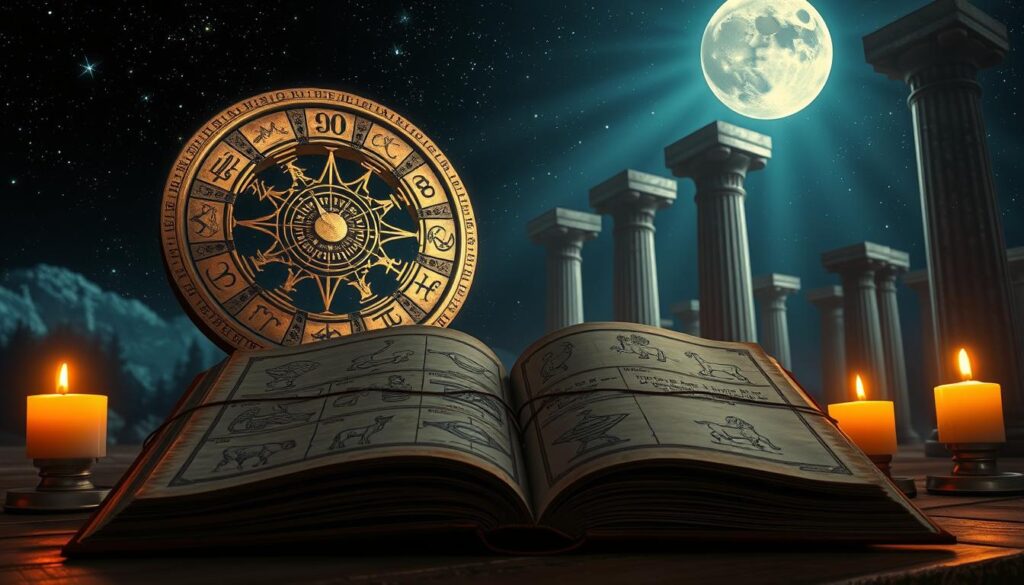
Babylonian Origins and Greek Adaptations
The Babylonians were among the first to develop a structured astrological system. They divided the sky into twelve parts, each linked to specific symbols and traits. This system laid the foundation for the zodiac’s twelve signs.
Later, the Greeks adopted and expanded these ideas. They introduced mythological stories to explain the constellations. For example, the story of Aries, the ram, reflects the Golden Fleece legend. This blend of astronomy and mythology shaped the zodiac’s cultural significance.
The Zodiac’s Journey Through Ancient Civilizations
The zodiac’s influence spread across the ancient world. In Egypt, the decanal system divided the night sky into 36 parts, focusing on star cycles. This differed from the Mesopotamian approach but shared a common goal: understanding celestial patterns.
In India, the Hindu adaptation introduced nakshatras, or lunar mansions. These added depth to astrological interpretations. Meanwhile, Islamic scholars like Al-Sufi preserved and enhanced star charts, ensuring the zodiac’s legacy endured.
Even in Europe, the zodiac found its place. The stained glass zodiac at Angers Cathedral, created in 1451, reflects its artistic and spiritual importance. Each culture added its unique perspective, enriching the zodiac’s global journey.
How the Zodiac Shapes Astrology
What makes the twelve signs so significant in astrology? The answer lies in the celestial mechanics and ancient traditions that define the zodiac. The ecliptic, the Sun’s apparent path across the sky, serves as the foundation for this system. By dividing this path into twelve equal parts, ancient astronomers created a framework that connects the stars to human traits.
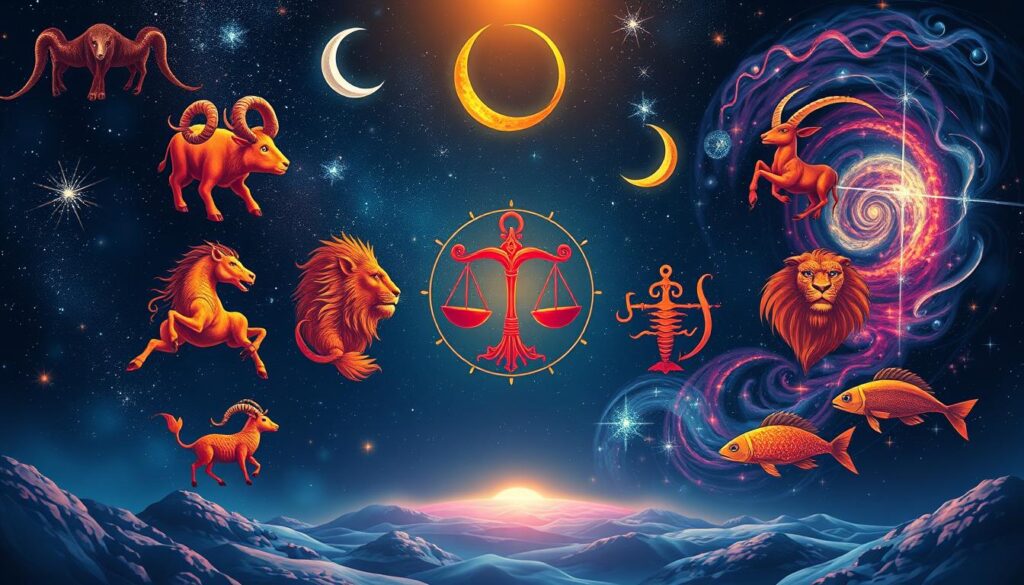
The Role of the Ecliptic and Celestial Coordinates
The ecliptic is a key concept in astrology. It represents the Sun’s journey through the sky over a year. Ancient civilizations used this path to map the stars and assign meaning to their positions. Celestial coordinates, like longitude and latitude, helped them divide the sky into precise segments. This division allowed for the creation of the twelve signs, each spanning 30 degrees of the ecliptic.
Why 12 Signs? The Math Behind the Zodiac
The choice of twelve signs isn’t arbitrary. It’s rooted in Babylonian mathematics, which used a base-60 system. This system made it practical to divide the 360-degree circle into twelve equal parts. Additionally, the twelve lunar months, totaling approximately 354 days, closely align with the solar cycle of 365.25 days. This mathematical harmony made the twelve-sign system both practical and symbolic.
Symbolically, the number twelve holds cultural significance. From the twelve Olympian gods in Greek mythology to the tribes of Israel, it represents completeness. Even the Chinese zodiac follows a twelve-year cycle based on Jupiter’s orbit. This universality underscores the enduring appeal of the twelve signs in astrology.
The 12 Zodiac Signs and Their Meanings
Understanding the twelve astrological signs can unlock deeper insights into personality and destiny. Each sign is associated with specific dates, elements, ruling planets, and traits that shape who we are. Whether you’re a fiery Aries or a compassionate Pisces, the zodiac offers a fascinating lens to explore your strengths and challenges.
![]()
The tropical zodiac, used in Western astrology, assigns dates based on the Sun’s position during the year. However, the actual constellations don’t align perfectly due to Earth’s axial wobble. For example, the 2024 vernal equinox occurs on March 19 at 8:06 PM EDT, marking the start of Aries season.
Here’s a comparison of tropical dates vs. constellation dates:
| Sign | Tropical Dates | Constellation Dates |
|---|---|---|
| Aries | March 21 – April 19 | April 19 – May 13 |
| Taurus | April 20 – May 20 | May 14 – June 19 |
| Gemini | May 21 – June 20 | June 20 – July 20 |
| Cancer | June 21 – July 22 | July 21 – August 9 |
| Leo | July 23 – August 22 | August 10 – September 15 |
| Virgo | August 23 – September 22 | September 16 – October 30 |
| Libra | September 23 – October 22 | October 31 – November 22 |
| Scorpio | October 23 – November 21 | November 23 – November 29 |
| Sagittarius | November 22 – December 21 | December 18 – January 18 |
| Capricorn | December 22 – January 19 | January 19 – February 15 |
| Aquarius | January 20 – February 18 | February 16 – March 11 |
| Pisces | February 19 – March 20 | March 12 – April 18 |
Each sign has unique characteristics. For example, Aries, a cardinal fire sign ruled by Mars, is known for its boldness and leadership. Famous Aries include Lady Gaga and Robert Downey Jr. Compatible signs for Aries are Leo and Sagittarius, while careers in entrepreneurship or athletics suit their dynamic nature.
Some astrologers, like Walter Berg, propose a 14-sign system, including Cetus. This system accounts for additional constellations intersecting the ecliptic. However, traditional astrology sticks to the twelve signs, preserving its ancient roots.
Zodiac Signs and Their Ruling Planets
The planets play a pivotal role in shaping the essence of each astrological sign. From fiery Mars to disciplined Saturn, these celestial bodies influence our personality and life path. Understanding their impact can offer deeper insights into your traits and behaviors.
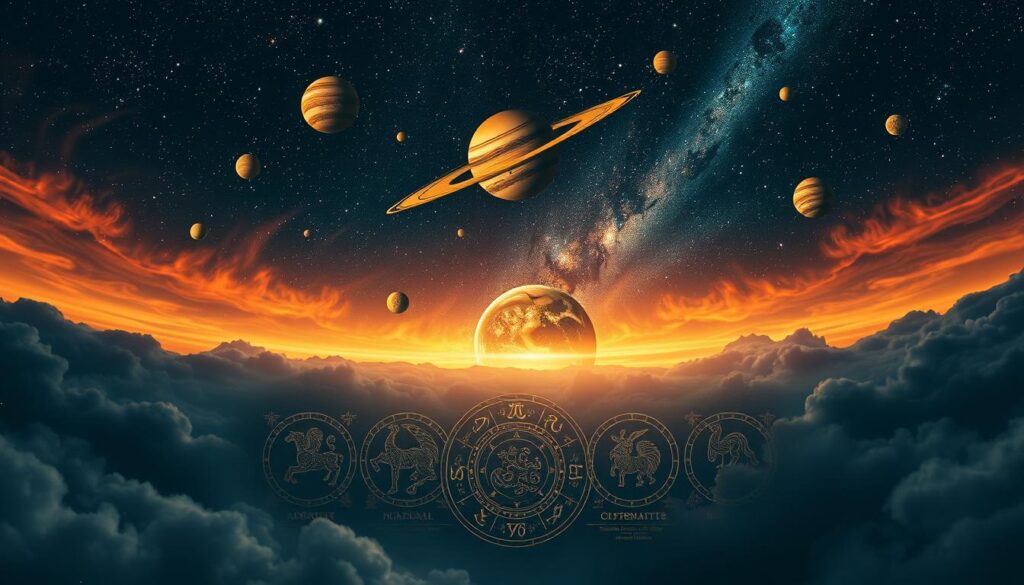
Traditional vs. Modern Rulerships
In astrology, each sign is governed by one or more planets. Traditional rulerships assign specific planets to signs based on ancient systems. For example, Aquarius is ruled by Saturn, symbolizing structure and discipline. However, modern astrology also associates it with Uranus, the planet of innovation and change.
Planetary Joys and Their Significance
Certain planets feel more at home in specific signs, a concept known as planetary joys. For instance, the Moon finds joy in Taurus, enhancing emotional stability and nurturing qualities. This alignment highlights how planetary placements at birth can shape your innate tendencies.
Mercury in Gemini vs. Virgo
Mercury, the planet of communication, behaves differently in Gemini and Virgo. In Gemini, it fosters curiosity and adaptability, making individuals quick thinkers. In Virgo, it emphasizes precision and analytical skills, leading to a detail-oriented approach.
Saturn’s Transit Through Signs
Saturn’s movement through the signs brings lessons and challenges. For example, its transit through Capricorn emphasizes ambition and responsibility, while in Cancer, it focuses on emotional boundaries and family dynamics.
Case Study: 2024 Pluto in Aquarius Shift
In 2024, Pluto will move into Aquarius, marking a significant astrological event. This shift will likely bring transformative changes in technology, society, and individual freedom. Understanding this transit can help you prepare for its influence on your life.
Planetary Retrograde Effects
Retrograde periods often bring introspection and delays. Here’s how retrogrades affect each sign:
- Aries: Focus on self-reflection and patience.
- Taurus: Reassess financial goals and values.
- Gemini: Revisit communication and relationships.
Domicile and Exaltation Table
| Planet | Domicile | Exaltation |
|---|---|---|
| Sun | Leo | Aries |
| Moon | Cancer | Taurus |
| Mercury | Gemini, Virgo | Virgo |
| Venus | Taurus, Libra | Pisces |
| Mars | Aries, Scorpio | Capricorn |
| Jupiter | Sagittarius, Pisces | Cancer |
| Saturn | Capricorn, Aquarius | Libra |
The Precession of Equinoxes: Why Your Sign Might Not Align
Did you know the stars you see today aren’t where they were thousands of years ago? This shift is due to a phenomenon called precession, a slow wobble in Earth’s rotation. Over time, this movement changes the alignment of the stars, impacting how we interpret astrological signs.
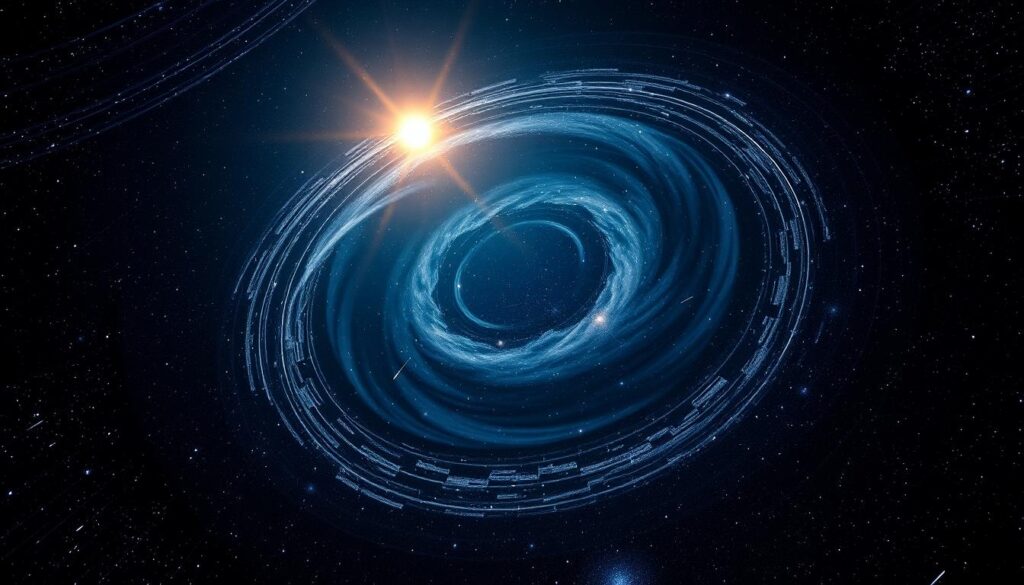
Earth’s Wobble and Its Impact on Astrology
Imagine Earth as a spinning top. Just like a top wobbles as it slows down, our planet experiences a similar motion. This wobble, known as axial precession, completes a full cycle every 25,772 years. During this time, the position of the stars shifts by about 1° every 71.6 years.
This means the constellations we associate with astrological signs today aren’t in the same place they were when the zodiac was first created. For example, since Ptolemy’s time, the stars have drifted by approximately 23°. This misalignment has led to debates about whether Ophiuchus, a constellation intersecting the ecliptic, should be included as a 13th sign.
Here’s a quick comparison of tropical and sidereal dates, showing how the drift affects astrological interpretations:
| Sign | Tropical Dates | Sidereal Dates |
|---|---|---|
| Aries | March 21 – April 19 | April 14 – May 14 |
| Taurus | April 20 – May 20 | May 15 – June 14 |
| Gemini | May 21 – June 20 | June 15 – July 16 |
| Cancer | June 21 – July 22 | July 17 – August 16 |
| Leo | July 23 – August 22 | August 17 – September 16 |
| Virgo | August 23 – September 22 | September 17 – October 17 |
| Libra | September 23 – October 22 | October 18 – November 16 |
| Scorpio | October 23 – November 21 | November 17 – December 15 |
| Sagittarius | November 22 – December 21 | December 16 – January 14 |
| Capricorn | December 22 – January 19 | January 15 – February 12 |
| Aquarius | January 20 – February 18 | February 13 – March 14 |
| Pisces | February 19 – March 20 | March 15 – April 13 |
While traditional astrology sticks to the tropical system, sidereal astrology accounts for this drift, offering a different perspective. Whether you follow one or the other, understanding precession helps explain why your sign might not align with the stars as they appear today.
Zodiac in Different Cultures
Astrology’s influence stretches across cultures, each with its unique interpretation of the stars. While Western astrology focuses on the Sun’s path, other systems like the Chinese and Hindu zodiacs offer distinct perspectives. These traditions reveal how astrology adapts to cultural values and beliefs.
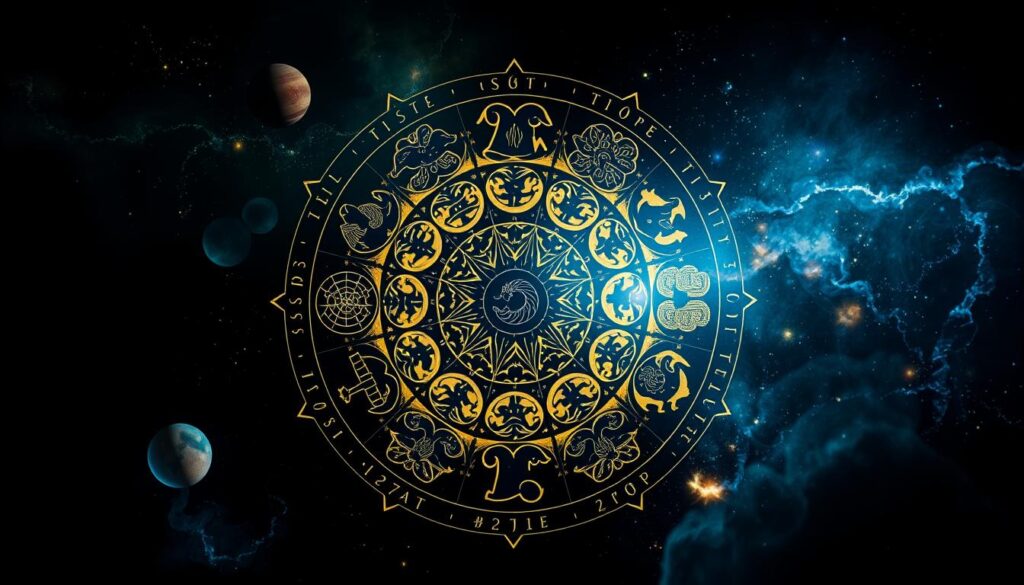
Western vs. Chinese Zodiac: A Comparative Look
The Western zodiac divides the year into twelve signs based on the Sun’s position. In contrast, the Chinese zodiac follows a twelve-year cycle, with each year represented by an animal. For example, 2024 is the Year of the Dragon, symbolizing power and luck.
While Western astrology emphasizes personality traits, the Chinese system focuses on life cycles and compatibility. Both systems, however, share a common goal: helping individuals understand their place in the universe.
Hindu (Sidereal) Zodiac: Stars Over Seasons
The Hindu zodiac, or sidereal system, aligns with the actual positions of the stars. Unlike the Western tropical zodiac, it accounts for Earth’s axial wobble, known as precession. This means the dates for signs like Mesha (Aries) start on April 14, not March 21.
Key features of the Hindu system include:
- Nakshatras: Lunar mansions that divide the sky into 27 parts, each with unique traits. For example, Ashwini nakshatra symbolizes speed and initiative.
- Dasha Periods: Planetary cycles that influence life events, offering insights into timing and challenges.
- Moon Signs: Unlike Western astrology’s focus on the Sun, Vedic astrology emphasizes the Moon’s position at birth.
The Panchang calendar, used in Hindu astrology, combines lunar and solar cycles to determine auspicious dates. This system highlights the deep connection between celestial patterns and daily life.
The Zodiac in Modern Astronomy
The stars have fascinated humanity for centuries, but how do modern scientists view astrology? While astrology interprets celestial patterns as influences on human life, astronomy focuses on understanding the universe through science. This fundamental difference often leads to disagreements between the two fields.
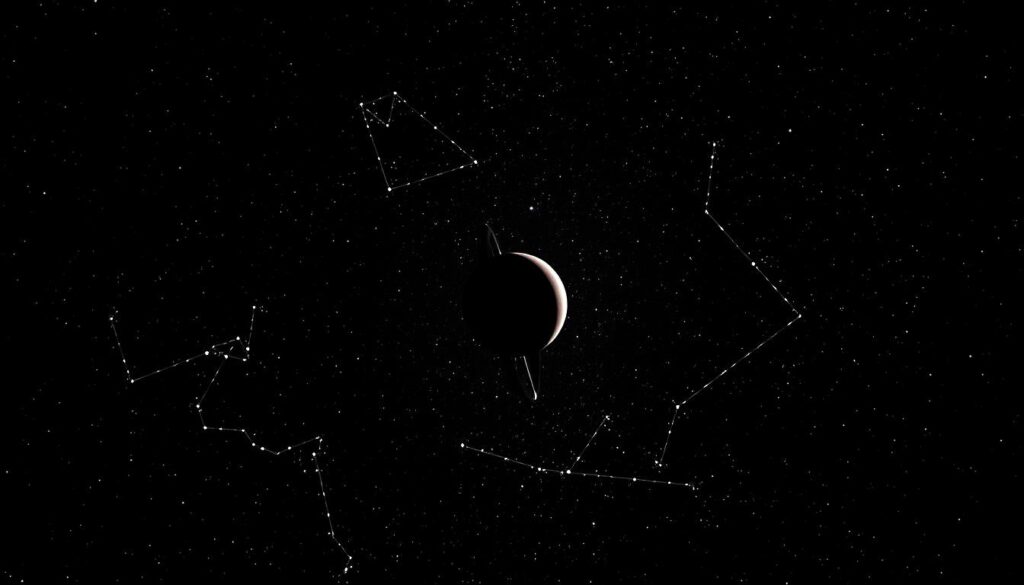
Why Astronomers and Astrologers Disagree
One key reason for the divide is the Barnum effect. This psychological phenomenon explains why people find vague, general statements personally meaningful. Experiments like the Forer test demonstrate how astrological descriptions can seem accurate, even when they apply to anyone.
Another point of contention is the lack of a proven mechanism for planetary influence. While astrology suggests that planets and constellations affect human behavior, astronomers argue there’s no scientific evidence to support this claim. The 1975 CSICOP challenge further highlighted this gap, as astrologers failed to demonstrate consistent predictive accuracy.
Renowned astrophysicist Neil deGrasse Tyson has been vocal in his critiques. He emphasizes that astrology’s interpretations don’t align with the physical laws governing the universe. For example, the gravitational pull of distant stars is negligible compared to Earth’s own forces.
Despite scientific skepticism, astrology offers psychological benefits. Many find comfort in its guidance, using it as a tool for self-reflection and decision-making. This emotional value keeps astrology relevant, even in the face of scientific rejection.
Astronomy vs. Astrology: A Comparative Look
| Aspect | Astronomy | Astrology |
|---|---|---|
| Focus | Scientific study of celestial objects | Interpretation of celestial influences |
| Basis | Empirical evidence and laws of physics | Symbolic meanings and traditions |
| Constellations | 88 officially recognized by the IAU | 12 zodiac signs |
| Planetary Influence | Gravity and physical interactions | Symbolic effects on personality and destiny |
While the two fields may never fully align, their coexistence reflects humanity’s enduring curiosity about the cosmos. Whether you’re drawn to the precision of astronomy or the introspection of astrology, the stars continue to inspire wonder.
Zodiac Symbols and Their Hidden Meanings
The symbols of the zodiac carry meanings that span centuries, from ancient carvings to modern digital icons. These symbols are more than just representations—they are windows into the history and culture of civilizations that first looked to the stars for guidance.

From Ancient Glyphs to Emoji: The Evolution of Signs
Zodiac symbols have evolved significantly over time. Ancient civilizations used glyphs to represent the constellations, often linking them to mythological stories or natural elements. For example, the symbol for Taurus, the bull, originated from depictions of bull horns in ancient Egypt and Mesopotamia.
Today, these symbols have found a new life in the digital age. The Unicode Consortium added zodiac emoji in 1993, starting with ♈︎ (Aries). This inclusion allowed these ancient symbols to become part of modern communication, bridging the gap between past and present.
Decoding the Symbols
Each zodiac sign has a unique symbol with a rich backstory. Here’s a closer look at a few:
- Taurus: The bull’s horns symbolize strength and fertility. In Egyptian culture, it was linked to Apis, the sacred bull.
- Libra: The scales are the only inanimate symbol in the zodiac, representing balance and justice.
- Gemini: The twins’ symbol traces back to Phoenician mythology, signifying duality and connection.
Symbol Evolution: From Ancient to Modern
The transformation of zodiac symbols can be seen in their journey from ancient reliefs, like the Dendera Zodiac, to today’s iOS emojis. This evolution reflects how these symbols have adapted to changing times while retaining their core meanings.
| Symbol | Ancient Representation | Modern Emoji |
|---|---|---|
| Taurus | Bull horns (Egyptian Apis) | ♉︎ |
| Libra | Scales of justice | ♎︎ |
| Gemini | Phoenician twins | ♊︎ |
Understanding these symbols offers a deeper appreciation for the zodiac’s enduring legacy. Whether carved in stone or sent as an emoji, they continue to connect us to the stars.
How to Use Your Zodiac Sign in Daily Life
Your astrological sign can be a powerful tool for self-discovery and growth. By understanding its unique traits, you can make informed decisions about relationships, career choices, and personal development. Let’s explore how to harness the energy of your sign in meaningful ways.
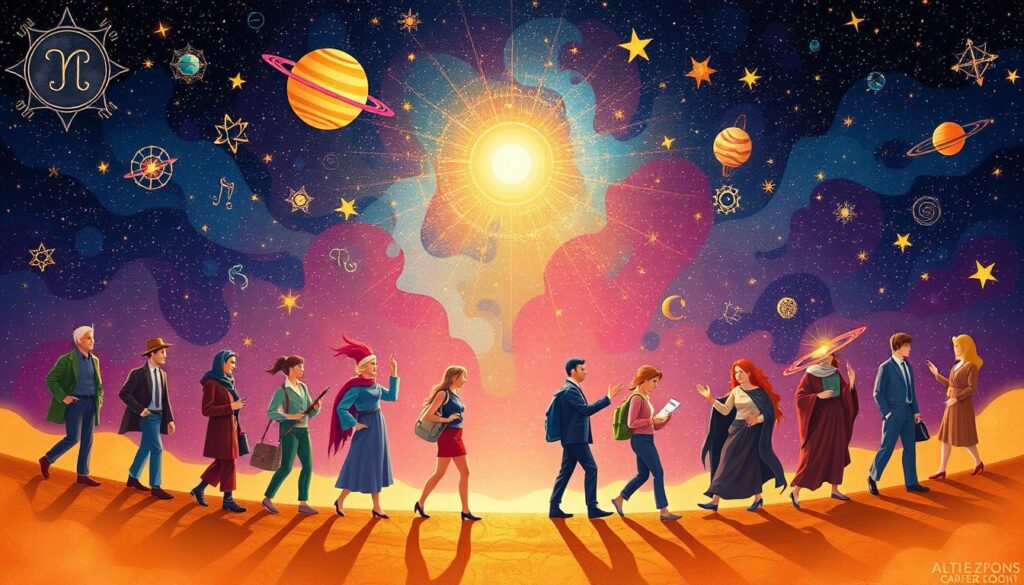
Compatibility: Friendships and Relationships
Astrology offers insights into how signs interact. For example, fiery Aries often connects well with adventurous Sagittarius, while grounded Taurus finds harmony with nurturing Cancer. These pairings highlight shared values and complementary strengths.
Here’s a quick guide to compatibility:
- Aries: Best with Leo and Sagittarius for dynamic energy.
- Virgo: Thrives with Taurus and Capricorn for stability.
- Gemini: Matches well with Libra and Aquarius for intellectual connection.
Understanding these dynamics can help you build stronger bonds with friends and partners.
Career Paths Aligned With Your Sign
Your sign’s traits can guide you toward fulfilling professions. For instance, Aries’ leadership skills make them excellent CEOs, like Marillyn Hewson of Lockheed Martin. Virgos, known for their analytical minds, excel in roles like Warren Buffett’s investment strategies.
Here’s how to match your sign to a career:
| Sign | Strengths | Career Paths |
|---|---|---|
| Aries | Leadership, Ambition | Entrepreneurship, Management |
| Virgo | Analytical, Detail-Oriented | Finance, Data Analysis |
| Gemini | Communication, Adaptability | Journalism, Public Relations |
Consider your sign’s natural abilities when exploring career paths. Whether you’re a creative Pisces or a disciplined Capricorn, there’s a profession that aligns with your strengths.
“Astrology helps us understand our potential and the roles we’re naturally suited for.”
By embracing your sign’s unique qualities, you can make choices that lead to personal and professional fulfillment. Whether it’s building relationships or advancing in your career, the stars offer valuable guidance.
Debunking Common Zodiac Myths
The stars have always sparked curiosity, but not all beliefs about them hold up to scrutiny. One of the most debated topics in astrology is the so-called “13th sign,” Ophiuchus. This constellation has stirred controversy and confusion, especially after a 2016 NASA article reignited the discussion on social media.
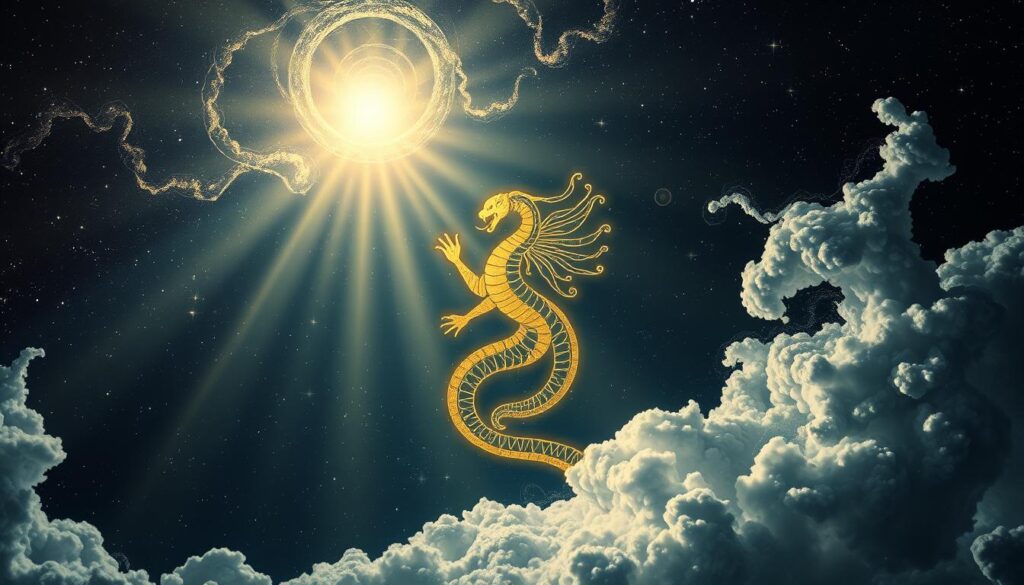
Ophiuchus: The Constellation vs. the Sign
Ophiuchus is a real constellation, but it’s not officially part of the traditional zodiac. The Sun traverses Ophiuchus between November 29 and December 17, yet it was excluded from the twelve-sign system. This distinction highlights the difference between constellations and astrological signs.
While constellations are groups of stars, zodiac signs are based on the Sun’s path through the sky. The Babylonians intentionally left out Ophiuchus to maintain their twelve-month calendar, a decision that still influences astrology today.
The 13-Sign Date Ranges
If Ophiuchus were included, the zodiac dates would shift significantly. Here’s how the calendar would look:
| Sign | Dates |
|---|---|
| Capricorn | January 20 – February 16 |
| Aquarius | February 17 – March 11 |
| Pisces | March 12 – April 18 |
| Aries | April 19 – May 13 |
| Taurus | May 14 – June 19 |
| Gemini | June 20 – July 20 |
| Cancer | July 21 – August 9 |
| Leo | August 10 – September 15 |
| Virgo | September 16 – October 30 |
| Libra | October 31 – November 22 |
| Scorpio | November 23 – November 29 |
| Ophiuchus | November 30 – December 17 |
| Sagittarius | December 18 – January 19 |
Astronomer vs. Astrologer Perspectives
From an astronomy standpoint, Ophiuchus is just another constellation. Astronomers argue that its exclusion doesn’t diminish its scientific significance. Astrologers, however, view the zodiac as a symbolic system, not a literal map of the stars.
A Buzzfeed survey revealed mixed reactions to the idea of a 13th sign. While some embraced the change, others felt it disrupted their connection to their traditional sign. This divide highlights the tension between science and belief in astrology.
Ultimately, whether you see Ophiuchus as a missing piece or a non-issue depends on your perspective. The stars will continue to inspire wonder, even as we question the myths surrounding them.
The Zodiac’s Influence on Pop Culture
The way we interpret the stars has evolved, leaving a lasting mark on culture and media. From newspapers to apps, astrology has found its way into our daily lives, shaping trends and sparking conversations.

Horoscopes in Media: A Journey Through Time
Horoscopes first appeared in newspapers in 1940, with the Sunday Express leading the way. Over the decades, they’ve become a staple in magazines, websites, and social media. Today, apps like Co-Star, valued at $40 million in 2023, bring personalized astrological insights to millions.
The evolution of horoscopes reflects our changing relationship with the stars. From Linda Goodman’s bestselling books to Sanctuary’s interactive platform, astrology has adapted to new technologies while retaining its core appeal.
Astrology in Modern Media
Social media platforms like TikTok have embraced astrology, with hashtags like #ZodiacTalk trending regularly. Users share memes, compatibility tips, and daily predictions, making astrology a part of everyday conversations.
Even Hollywood has joined the trend. Marvel’s Eternals introduced zodiac-inspired characters, blending ancient mythology with modern storytelling. This fusion of astrology and entertainment highlights its enduring relevance in pop culture.
Fashion and Celebrity Astrologers
Astrology has also influenced fashion, with designers creating zodiac-themed collections. From zodiac dresses to constellation-inspired jewelry, the stars have become a source of artistic inspiration.
Celebrity astrologers like Susan Miller have gained massive followings, offering insights into planetary movements and their impact on our lives. Their expertise bridges the gap between ancient traditions and modern media.
| Platform | Astrology Trend |
|---|---|
| TikTok | #ZodiacTalk memes and discussions |
| Marvel | Eternals’ zodiac-inspired characters |
| Fashion | Zodiac-themed clothing and accessories |
| Apps | Co-Star’s personalized horoscopes |
As astrology continues to evolve, its influence on pop culture remains undeniable. Whether through social media, fashion, or entertainment, the stars guide us in ways both ancient and new.
Conclusion
The stars have long been a source of wonder and inspiration for humanity. The zodiac serves as both a scientific framework and a cultural touchstone, blending ancient traditions with modern curiosity. While its celestial patterns are rooted in astronomy, its interpretations in astrology offer a unique lens to explore personality and purpose.
As you delve into this guide, remember to approach astrological claims with a critical mind. While the stars can provide insights, they should complement, not dictate, your decisions. For those eager to learn more, resources like natal charts and reputable astrological platforms can deepen your understanding.
Ultimately, the zodiac invites us to reflect on our place in the cosmos. As Carl Sagan once said, “We are made of star-stuff.” Let this connection inspire you to explore the mysteries of the universe and your own life with curiosity and wonder.

